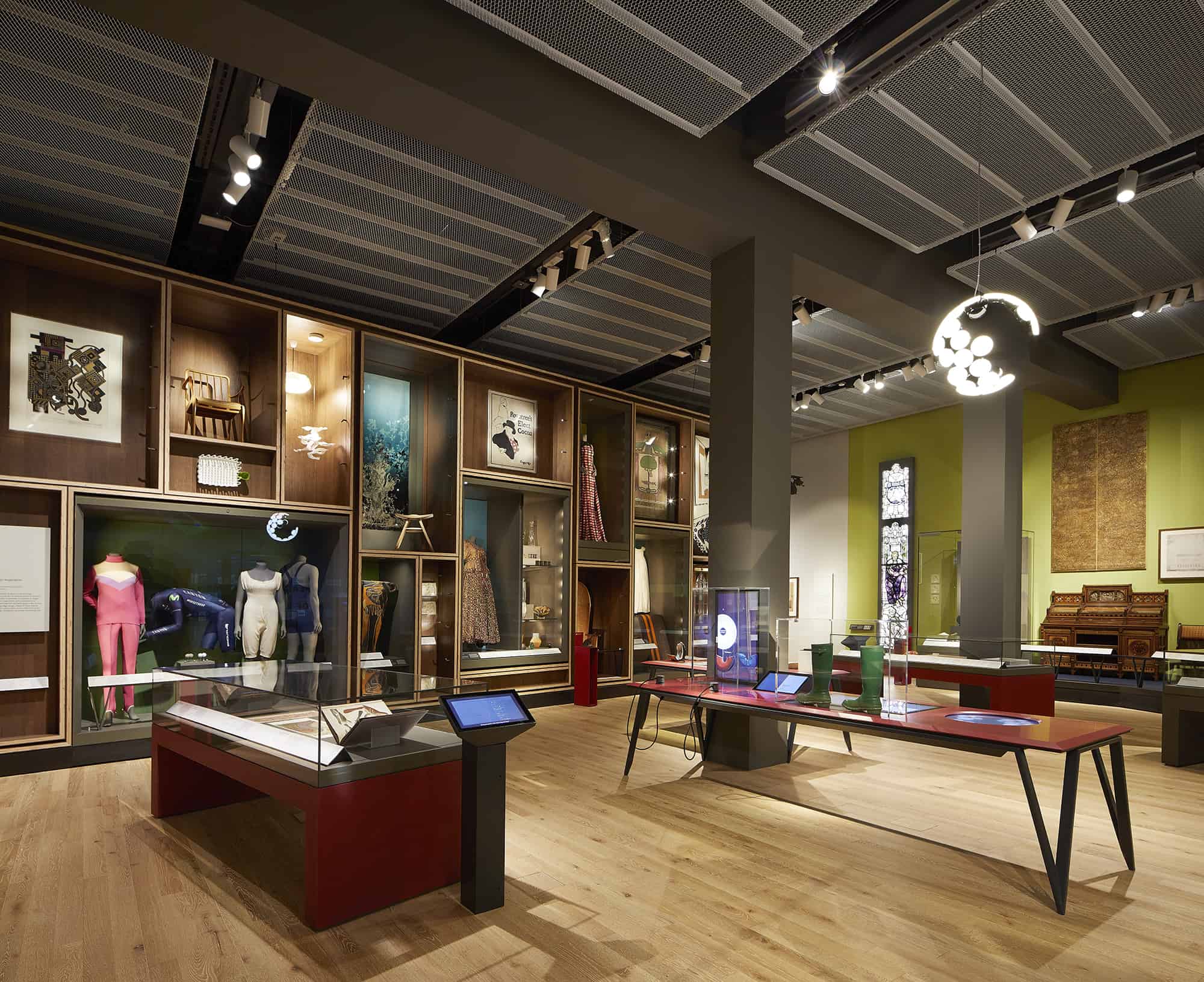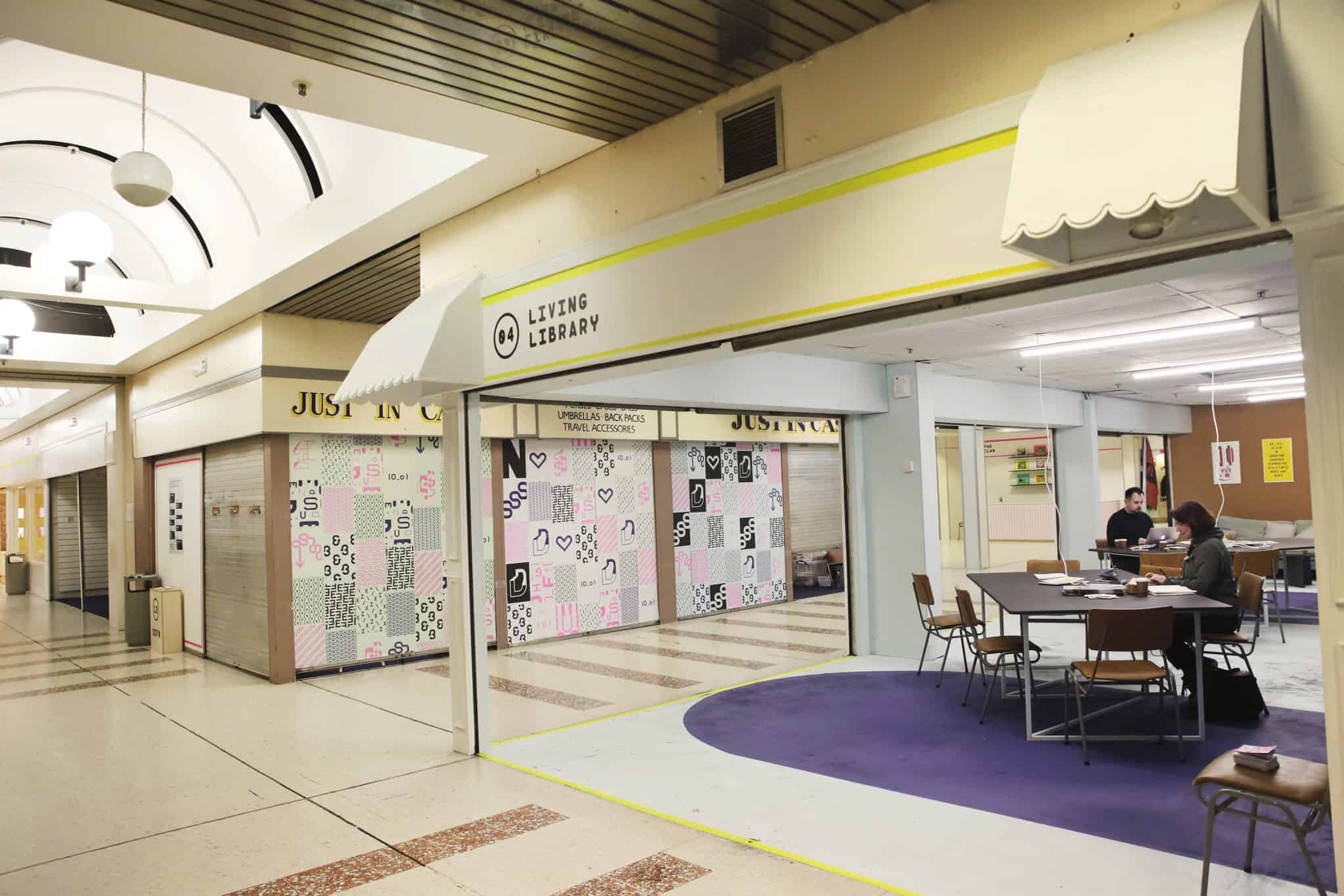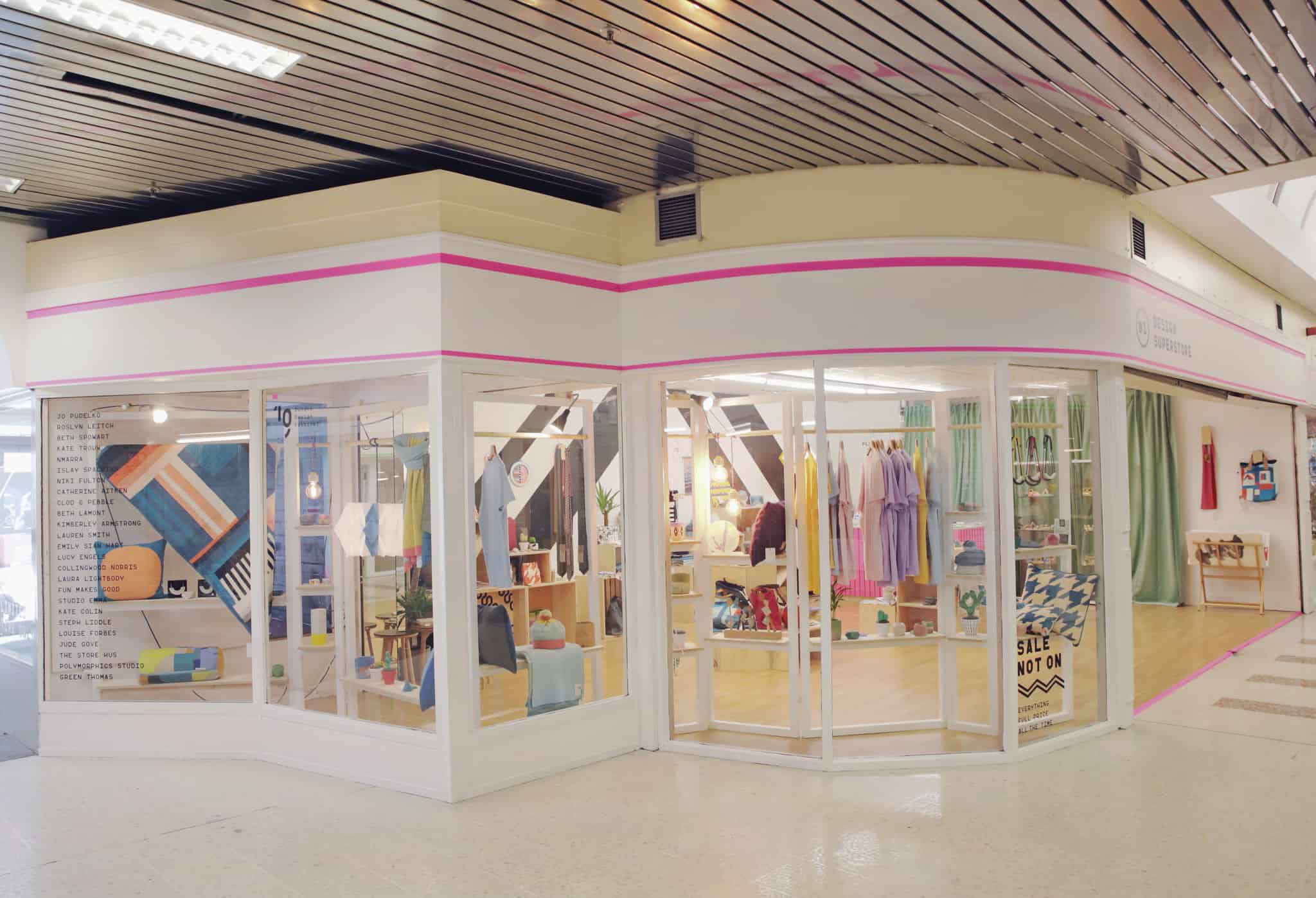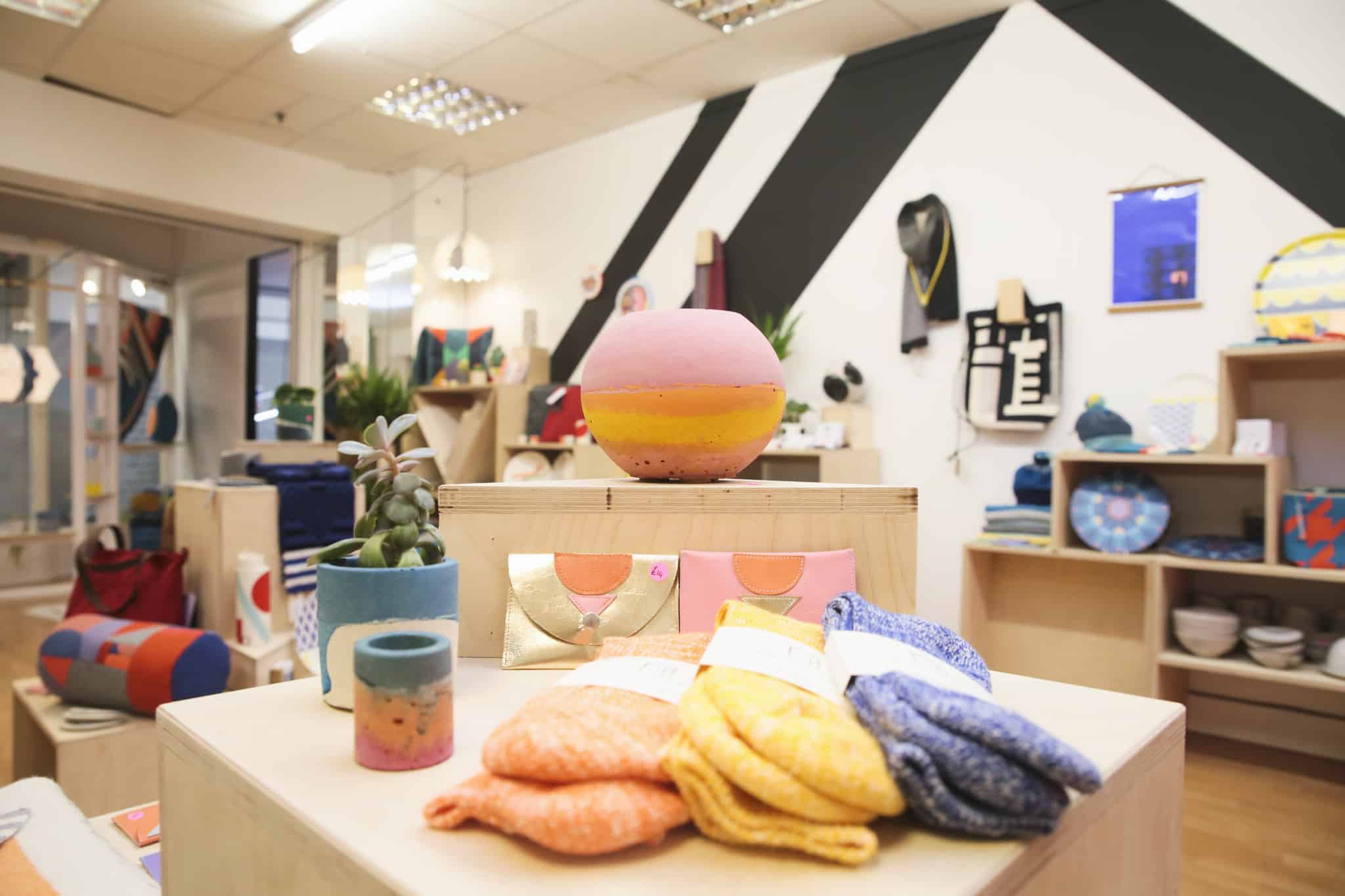The once industrial harbour town embarks on a quest of reinventing itself as the country’s capital of design, with the first and only Scottish V&A museum already established in its nascent years as a familiar regional landmark and a catalyst for local cultural activity.
Outset against the shabby greyness of the downtown, right on the River Tay waterfront shines a dark pearl or, rather, a geometric curiosity formed by two inverted and conjoined parts of a halved cube. The exterior of stone panels mirrors on the glittering waters of two reservoirs underneath the shape hovering before the visitors’ eyes.

V&A Dundee Scotland, ©Hufton Crow.
V&A Dundee, opened in 2018, is the first UK project of the renowned Japanese architect Kengo Kuma. The motif of reconnection proved the right inspiration. A reunion of the city and the newly reinvigorated riverside echoes the gallery’s motto: ‘past, present,’ and an outlook into the ‘future’ of ‘Scottish heritage’. It combines the past, imitating the quintessential northern coastline cliff face with the rough yet shiny stone panels, and modernising geometrical aesthetics of the slightly curved external walls. The heaviness of the cube is juxtaposed against the lightness of the levitating twenty one stone bands.
The volatility of the structure is emphasised by the spaciousness of the interior, the ‘living room for the city’ as Kuma deemed it to be, where overlapping bright oak-veneered panels replace concrete and natural light comes from the numerous hatch-small windows as well as the larger ones on the upper floor. Openness to sunlight does not surprise, given the majestic Tay bridges view from the terraces, connecting the interior of the building partially built on water with its surroundings. A serpentine of stairs rounding the ground-level entrance hall leads to the second floor’s exhibition space.
Scottish Design Galleries consist of four high-ceiling dim-lit rooms, where numerous objects in the collection, consisting of a total of six hundred – shared with V&A South Kensington – jostle for space and attention. There are few information plaques; the curatorial team eschews over-historicising the exhibition, letting the exhibits tell their stories themselves, when compared and contrasted with their neighbouring Elizabethan, Victorian, or modern counterparts. Rather than positing an interpretation of the story, emphasis is put on the themes, materials and patterns that recur over the six hundred years’ time span, including the trademark tartan and tweed: from the very oldest surviving textile samples to an early suit of Vivienne Westwood. From the folk toy designs to Eduardo Paolozzi’s plastic-mould orthogonal Elephant.

V&A Dundee Scotland, ©Hufton Crow.
What solicits highest praise is the section dedicated to architecture. The exhibition traces the progression from an inspiration drawn from rustic forms, through paper models to photographic documentation of actual buildings. They include Dualchas’ 2014 Saltire Award winner Colbost from the Isle of Sky – a contemporary twist on the traditional islander’s shed, hidden behind a hill from the incessant wind, on the slope towards the coast. Maintaining the shape and black-stained colours yet connecting the interior through panoramic transparent walls to the picturesque scenery, the family house seems rooted in its landscape.
V&A Dundee is first and foremost a contemporary gallery where the twenty-first century reigns supreme. Two auditoria, an open area for community events and the resident designer’s roomy project space accompany the temporary exhibition room, large enough to host touring shows from the gallery’s Londoner sister. The recent Videogames: Design/Play/Disrupt pays homage to the bustling game-design scene of Dundee – a city that hosts world-famous studios and leading university courses in programming and design. Lastly, they have been exploring the aesthetics of robots in our daily lives.
Not for lack of trying, the aim set in the motto seems yet to be accomplished. Imagining future cities with the digital screen as their fabric, not a reconnection but a violent (and reckless?) breakup with the past seems bespoken, leaving the said three-fold nature of Scottish heritage still partitioned. The sterile whiteness of shiny polymeric surfaces, all but ornate, contains less than little reference to Scots’ historic contributions.

V&A Dundee Scotland, ©Hufton Crow.
Although a similar feeling may be evoked by the modest number of local artists featuring in temporary exhibitions, this is to be soon alleviated by the planned shift in focus to Scotland’s modernist legacy. An upcoming show will offer a retrospective of the fashion designer Mary Quant, surveying her bold cuts and playful colours which once shone amongst the lights of the very first dancefloors and on the concrete streets of brutalist districts.
V&A Dundee seems the jewel in the crown of a £1 billion transformation of the city’s slightly faded waterfront. And a firm part of the cultural fabric Dundee is eager to expand. With the ambition to become a hub of innovation and creativity, emphasis is put on design and new media. Dundee is home to the leading Jordanstone College of Art & Design and the Abertay University which offers the world’s first course in video game design since 1997.
In 2014, while construction of V&A was underway, Dundee was designated as one of the 37 UNESCO Cities of Design. It is still the only UK city on the list. Scotland’s first design gallery doubtlessly strengthened the bid and still contributes to the city’s strategy of culture-focused redevelopment. V&A Dundee is a considerable commercial success – the millionth visitor was welcomed in February.
Managing to pull in the first ever embassy of the Londoner arts and crafts divine abode, Dundee heralds its aspirations to the artworld, stands tall and boasts about hosting Scotland’s only gallery dedicated to design. V&A Dundee exemplifies how a city’s burst of creative energy and redevelopment strategy focused on the arts can spectacularly materialise.
Written by Franciszek Bryk

V&A Dundee Scotland, ©Hufton Crow.
Design Superstore, Dundee Design Festival 2019. Photographed by Kathryn Rattray.
Design Superstore, Dundee Design Festival 2019. Photographed by Kathryn Rattray.
Design Superstore, Dundee Design Festival 2019. Photographed by Kathryn Rattray.













